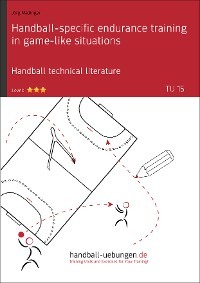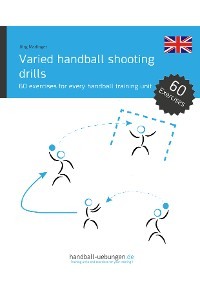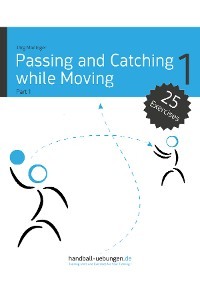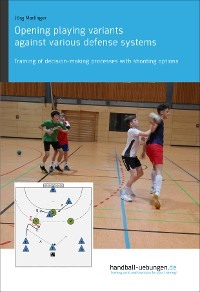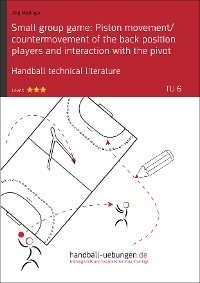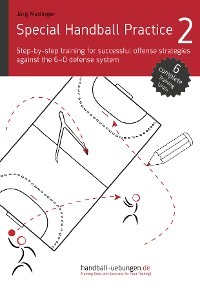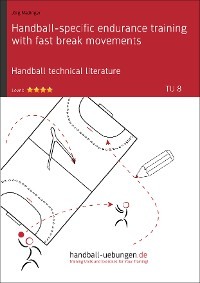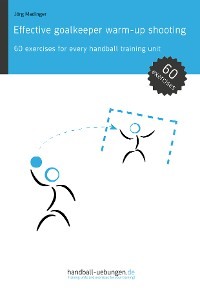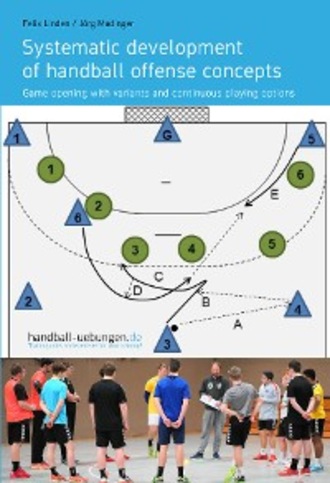
Полная версия
Systematic development of handball offense concepts

Introduction
Dear reader
This is the second time Felix Linden (A-License and certified DHB young talents’ coach for competitive areas) gives insights into his understanding of diverse and focused handball training in the book series of handball-uebungen.de. Based on crossing of the center back and the pivot (circle) – which is part of almost every team’s repertoire in various forms – Felix Linden explains how you can create different game situations by using simple extensions and hence overcome defense systems with many variants. The individual training units deal with essential elements such as pulling apart a 6-0 defense system, authentic piston movements, pulling out a defense player, different shooting options, and decision-making. All training units focus on decision-making processes in particular. The training units comprise the standard playing structures with continuous playing options on both sides, variants with a second pivot and position switching as well as a variant for outnumbered game situations.
Within the last few years, several counteractive defense measures have been developed in order to interrupt the back position/pivot circle. Consequently, it is important to practice different situations with regard to the back position/pivot circle. The last chapter shows various defense measures and provides an idea of which variants should be played in each situation.
This book contains the following training units:
- Game concept – Crossing of the center back and the pivot – Part 1
- Game concept – Crossing of the center back and the pivot – Part 2
- Game concept – Crossing of the center back and the pivot plus second pivot from the wing position
- Game concept – Crossing of the center back and the pivot plus second pivot from the back position
- Crossing of the center back and the pivot in outnumbered situations
Difficulty levels of the training units:










Thanks go to the first ladies’ handball team and the male under-19 handball team of ATV Biesel for their active support during the training units.
Felix Linden will donate parts of the revenue to the charity “United Smile e.V.”. With his charity, Jens Dauben, a dentist and one of Felix Linden’s players, supports children and adults in remote regions of the world who do not have access to dental and medical standard care.
Publishing information
1st English edition released on 28 Aug 2018
German original edition released on 07 Jun 2018
Published by DV Concept
Editors: Felix Linden, Jörg Madinger
Design and layout: Jörg Madinger, Elke Lackner
Pictures: Gisbert Schlemmer
Proofreading and English translation: Nina-Maria Nahlenz
ISBN: 978-3-95641-218-9
This publication is listed in the catalogue of the German National Library. Please refer to http://dnb.de for bibliographic data.
The work and its components are protected by copyright. No reprinting, photomechanical reproduction, storing or processing in electronic systems without the publisher's written permission.
1. Training units
1.1 Game concept – Crossing of the center back and the pivot – Part 1
Description:
Following warm-up with two ball familiarization exercises, this training unit introduces crossing of the center back and the pivot as the basic action already during the goalkeeper warm-up shooting and a subsequent series of shots. Afterwards, the players practice how to make decisions when the ball is passed to the back position players. This is followed by a further small group exercise and eventually the final team exercise during which the players should directly implement a first variant when playing the initial pass.
Difficulty:



The training unit consists of the following key exercises:
- Warm-up/Stretching (individual exercise: 10 minutes/total time: 10 minutes)
- Ball familiarization (10/20)
- Ball familiarization (10/30)
- Goalkeeper warm-up shooting (10/40)
- Offense/Series of shots (15/55)
- Offense/Small groups (10/65)
- Offense/Small groups (15/80)
- Offense/Team (10/90)
Training unit total time: 90 Min.
Key:






Equipment required:
- 2 foam noodles (foam beams)
- 1 upper part of a large vaulting box
- 2 cones
- 2 ball boxes with sufficient number of handballs
No.: 1-1 Warm-up/Stretching (10/10)
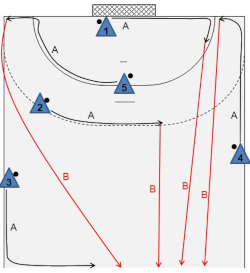
Course:
- The players each have a ball and run along the lines on the court floor (A).
- While doing this, they perform different running moves as instructed by the coach:
→ Dribbling the ball with the right/left hand.
→ Dribbling the ball with the right/left hand alternately.
→ Sidestepping while dribbling the ball.
→ Hopping and handing over the ball from the right to the left hand (and back) above the head.
→ Running backward and moving the ball around the hips in circles (see figure).
- The coach whistles after a while and defines a target which the players must touch (e.g. goal post, center line (B), a corner of the playing field, a green line, something red (not worn by the player himself) etc.).
- The players sprint and try to fulfill the task as fast as possible.
- The last player must fulfill an extra task (10 quick jumping jacks, 10 push-ups etc.).
- Afterwards, the players perform stretching/mobilization exercises together.
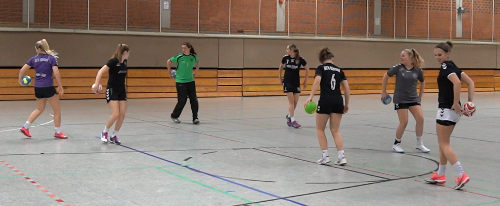
No.: 1-2 Ball familiarization (10/20)
Setting:
- The players stand in a circle,

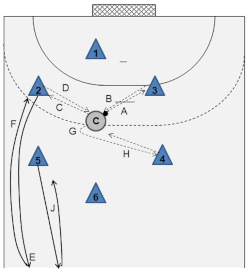
Course:
-

- Before a player may receive a ball (A), he must clap his hands one time, then catch the ball, and pass it back again (B).
- If a player misses to clap, or if a player fails to catch the ball, he must sprint to the center line (E)
and back (F).
-

- If a player claps even though he does not get the ball, he must also sprint to the center line (J).
Variant:
- Instead of

- For large groups, divide the players into two smaller groups.


No.: 1-3 Ball familiarization (10/30)
Setting:
- Define the running path with cones.
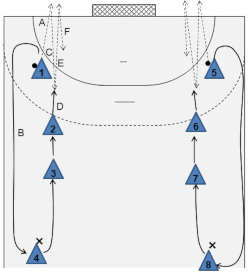
Course:
-

-

-



- Bounce it against the wall directly and catch it directly.
- Bounce it against the wall indirectly (bounce pass) and catch it indirectly (after it bounced on the floor one time).
- Bounce it against the wall indirectly and catch it directly.
No.: 1-4 Goalkeeper warm-up shooting (10/40)
Setting:
- Define the starting position of the pivot as well as the shooting corridor with two foam noodles (foam beams).
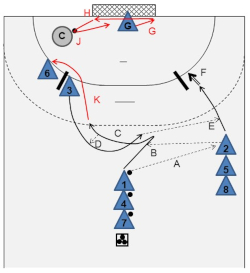
Course:
-


-

-


-


- The goalkeeper starts from the center of the goal and tries to save the shot (G).
-



- After the shot,



-





No.: 1-5 Offense/Series of shots (15/55)
Setting:
- Define the starting position of the pivot as well as the shooting corridor for the pivot with two foam noodles (foam beams).
- Position the upper part of a large vaulting box as shown in the figure for the shot from the right back position.
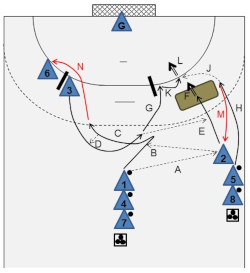
Course:
-


-

-


-


- After the pass,

-


-

-



-




No.: 1-6 Offense/Small groups (10/65)
Setting:
- Define the playing field for the 3-on-2 game with foam beams.
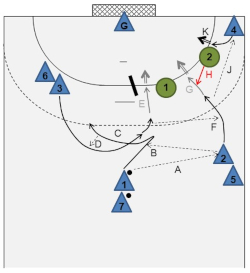
Course:
-


-

-


- If there is a large gap next to


- Usually,


-

- If











